October 22, 2013: National Day of Protest to Stop Police Brutality, Repression, and the Criminalization of a Generation
Updated November 1, 2013 | Revolution Newspaper | revcom.us
Actions for October 22, 2013, the 18th National Day of Protest to Stop Police Brutality, Repression and the Criminalization of a Generation, were called for in more than 50 cities, across the United States and in two cities in Canada. Revolution received the following initial reports of protests on October 22. Check back for additional reports that will be posted as we receive them.
Oakland
O22 was marked by car caravans, a rally of over 120 people and a spirited march through the Fruitvale District, ending with a speech at the Fruitvale BART station by Oscar Grant's uncle, Cephus Johnson. Following the speech, there was a film showing of disc 1 from BA Speaks: Revolution—Nothing Less in Fruitvale Plaza.
After a short rally in East Oakland a car caravan took residents from this hood to the rally in the Fruitvale District, going through neighborhoods where police had killed Alan Blueford and Brownie Polk and many others, and where countless numbers of youth are being criminalized and brutalized every day.
At Fruitvale Plaza 120 people had gathered for a rally, over half young and of all nationalities. There were 15-20 college students from Diablo Valley College, Laney and Merritt College and UC Berkeley, as well as youth from different high schools in Oakland and San Francisco, folks from Occupy Oakland, Food Not Bombs, church groups, several immigrant rights groups, family of victims of police murder and abuse, anarchists, and people from the Revolution Club of the Bay Area as well as members of Stop Mass Incarceration Network who had announced the demonstration in a widely distributed leaflet. The rally was also announced on KPFA radio by Davey D as well as social media including #Occupyoakland.
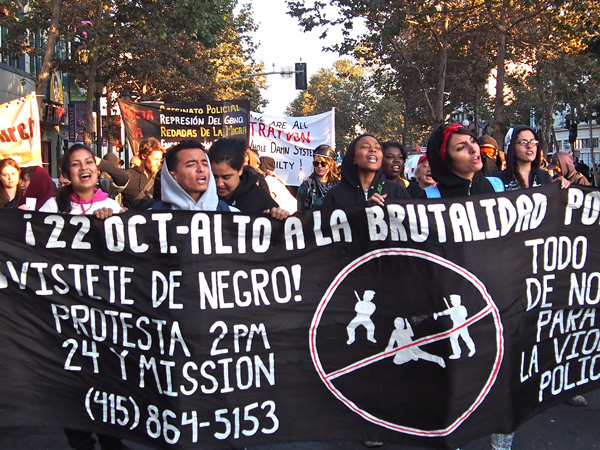
Oakland, CA, October 22, 2013
Speakers at the rally included Mara Randall, a teacher who was beaten and arrested during the Oakland Occupy and featured in a documentary of this brutal assault. A sizeable contingent came from Merritt College, and four members of their Black Students Union took the stage as their president spoke of Black people's very “existence” being threatened—"the cops are killing us." Other Merritt students included members of the MLK Jr. Freedom Center. A young woman from a group protesting Urban Shield spoke about the increasing militarization of the police.
Glide Church members came with their banner from San Francisco, and Rev. Dr. Karen Oliveto took the stage. In July, she had given a sermon from her pulpit inside a mock SHU isolation unit in support of the recent California prisoners' hunger strike against the conditions of solitary confinement. She was passionate as she spoke about the need to act now against the criminalization of the youth, especially because of Trayvon Martin. A Stop Mass Incarceration Network speaker also spoke to this as well as linking it up with the fight to stop torture of massive numbers of people who are locked up.
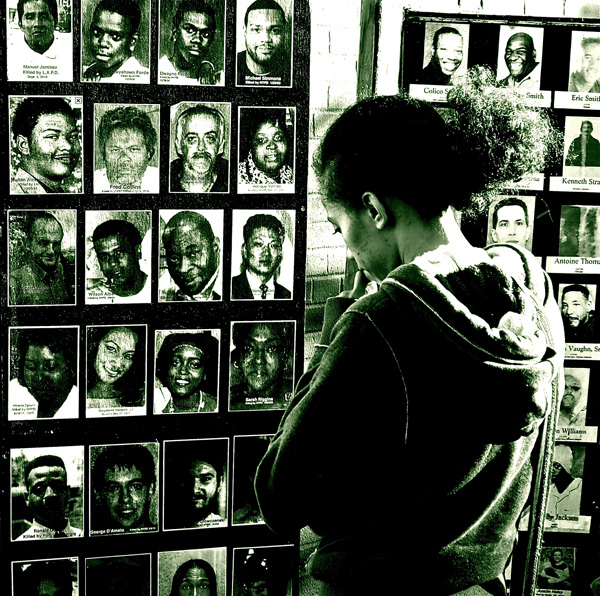
Oakland, CA, October 22, 2013
Other speakers included a woman from Mujeres Unidas y Activas who spoke of the link between mass deportation of immigrants and the role of the police—one of their slogans used in the rally and march translates as “police and La Migra, the same filth.” Some of their members had recently been involved in civil disobedience, blocking a deportation bus in the Bay Area. Importantly, she also spoke of the attacks on immigrant women who are afraid to go to authorities for fear of being deported when they are beaten! And the desperate feeling of children when they come home to learn that their parents were detained to be deported.
Revolution writer Larry Everest read the O22 statement from the Revolutionary Communist Party, and the crowd which had grown to 150 drew nearer to the stage and listened intently as he talked about strategy for and the possibility of revolution, including the significance of both police murders of youth and the recent government shutdown. Drawing from the film BA Speaks: REVOLUTION—NOTHING LESS!, Everest urged people who wanted a solution to "Get With BA ... and GET THIS FILM!"
2013 Youth Poet Laureate of Oakland, Obasi D. Davis, ended the rally with a fiery poem, "Hunting Day"—one of the lines says "Oscar Grant is dead, but I'm still alive!"... and this became the call to begin the march.
About 60-70 people in the crowd took off up Fruitvale Avenue with a lot of fanfare. A couple of people from the East Oakland hood took the bullhorn up with passion, assisting the agitators with chanting, "We are all Trayvon Martin, hoodies up/hoodies up"; "If you don't like Stop and Frisk, let me see you raise your fist"; "OPD what do you say, how many kids did you kill today?"; "NO MORE ... mass incarceration....criminalization"; "Being Black is not a crime, but the pigs still fuck with you all the time"; and several others.
As the march began a loop, neighbors stepped out of their porches to watch, applaud, honk horns, and buy copies of Revolution (altogether 120 copies were distributed, as well as dozens of "Three Strikes" posters, large copies of Basics 1:24 on the role of the police; flyers promoting a November 15 Berkeley film showing of BA Speaks: REVOLUTION—NOTHING LESS!. There was a notable increase in police presence at this point as well with a copter in the air and 13 cop cars in a nearby parking lot.
As the march returned to the plaza, a crowd of local residents raised their fists in solidarity. The march continued to the train station itself where Uncle Bobby, Cephus Johnson, spoke beneath the platform where his nephew Oscar Grant was killed by the police in 2009. Uncle Bobby spoke of the importance of acting on the spot when people see police abuse and not just letting it go. He mentioned the arrest and conviction of Johannes Mehserle, the BART cop who killed Oscar Grant, as being "not a victory, but historic"... and he mentioned the importance of people stepping up and taking pictures as being very important. He said we cannot just step aside and let it go, but we must ACT to stop these criminal actions of the police.
To cap off the day, some people stayed to watch part of the movie BA Speaks: REVOLUTION—NOTHING LESS! on the plaza wall—bringing meaning to the Revolution Club slogan, "Fight the power, and transform the people, for revolution."
Sacramento
A powerful demonstration 400-500 strong was held at the California State Capitol—organized by "A California Campaign to Stop Police Brutality," a state-wide network including over 50 families of victims of police murder. The demands included stopping the ICE immigration raids, abolishing the SHU, and ending mass incarceration. The protest enunciated not only the heavy toll of this epidemic but the fighting, defiant spirit of the families who organized with each other, speaking out, sharing materials, demanding justice for their loved ones and an end to police brutality, repression and the criminalization of a generation.
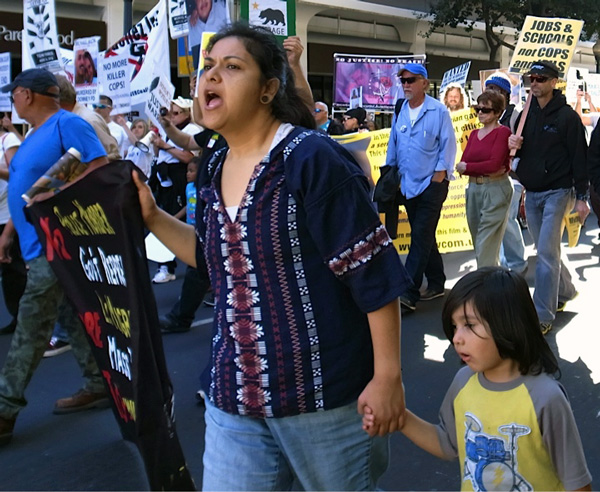
Sacramento, CA, October 22, 2013
Speakers included many family members, including Cephus Johnson, uncle of Oscar Grant, and lawyers, clergy, and other activists including speakers from Stop Mass Incarceration Network, and Larry Everest reading a statement on O22 from the RCP. A model of the SHU was set up, and excerpts of the film BA Speaks: Revolution—Nothing Less! were played inside.
Latino, Black, Asian and white family members expressed their outrage and determination throughout the day, over the mic, and talking with others.
"They tased him and beat him to death!" "They shot my brother Mario Romero 30 times!" "Ernest was unarmed." "We won't be intimidated." "We were looking for medical assistance for Robert, and my son received death." "We won't stop until there is justice." "We're letting them know that we will not be silenced." "Micah...killed in Reno, Nevada on Christmas Day. Tased 26 times." "I thank all of you for making me strong because I know you are gone through horrible things, cause your pain is as bad as mine."
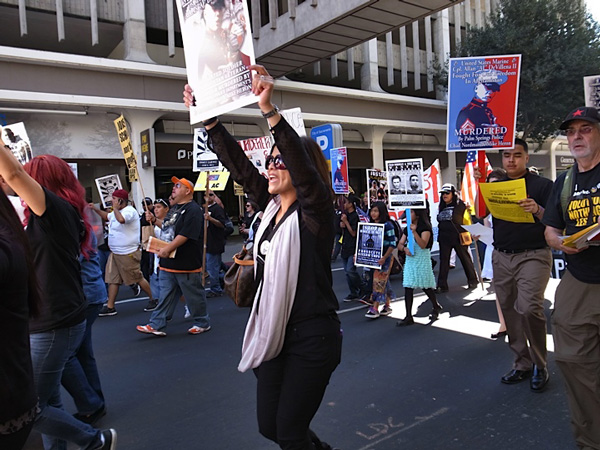
Sacramento, CA, October 22, 2013
For many this was the first time they had protested on October 22nd. People came from all over the state, and at least one mother and grandmother came from Nevada. About 45 family members came from Anaheim alone, where there have been over 40 police shootings in the last 10 years, over 20 of them resulting in a death, every one of these murders found "justifiable" by the authorities.
There was a march to the State Attorney General's office where one person from each family spoke the name of their murdered loved ones and laid a red rose on a stylized casket in front of the doors of the building.
Many of the people had been harassed by the authorities for speaking out and demanding justice—one woman had been pulled over the day before because she had a poster for the protest on her car window. Another woman said she had been stopped by police in her town 42 times, because she had written her brother's name and the cops who killed him across the back window of her car. But this harassment has backfired and hardened the resolve to fight for justice. Many copies of Revolution newspaper were distributed, as people struggle to understand both the root cause of this epidemic, and the solution.
Los Angeles
A march of close to 200 people on Crenshaw Blvd rekindled some of the resistance and defiance that had filled the streets for several days this past summer after the verdict acquitting the killer of Trayvon Martin. The day was full of rage and joyful, celebratory defiance. People were dressed in all black, and hoodies were up.
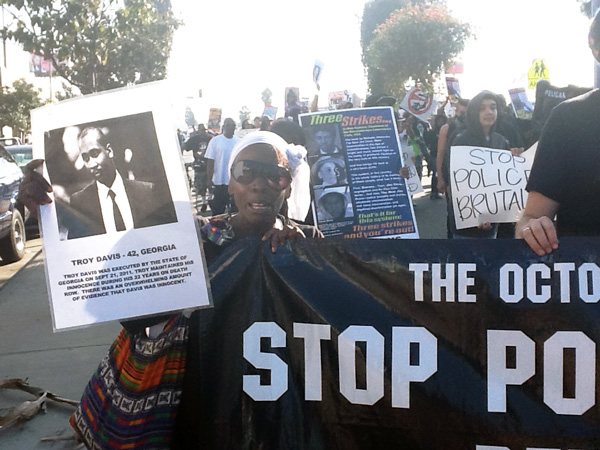
Los Angeles, CA, October 22, 2013
The march was fiercely contentious with the LAPD who had denied the permit at the last minute—for the first time in 18 years of October 22 marches. But this did not stop the people who were determined to expose and protest rampant police brutality and murder, mass incarceration, torture in U.S. prisons, attacks on the undocumented, discrimination and police harassment of LGBT people, and heightened repression in the U.S. There was media coverage of the event in the Los Angeles Times, La Opinión, CBS and KCAL news television, Huffington Post Los Angeles, RT TV, USC Annenberg News, and other media outlets.
People stepped off chanting, “Oink, oink, bang, bang, every day the same old thing...” behind a Stolen Lives truck covered with pictures of people killed by the police and a Trayvon banner that read, “We are all Trayvon, the whole damn system is guilty.”
The march included students, activists, family members of people killed by the police, families with loved ones locked down in prison and in solitary isolation, revolutionaries, and others deeply affected by the murder of Trayvon Martin, sick and tired of the official murder and brutality and the targeting and criminalization of Black and Latino youth. All along the march people at bus stops and stores took up stickers and flyers to spread word of the resistance.
After a few blocks, the march turned off the main street to pass by Crenshaw High School as students were coming out of school. The police, who had been hounding the youth in the area the day before (like they do EVERY day), were trying to derail and control the march and were also inside the school forcing students to leave out of the back door. But this didn't work.
As the Stolen Lives truck stopped in front of the school, people called on the students to come out and scores of students rushed into the march, grabbed bullhorns, shouted "Fuck the Police" and began dancing in the street. Some students talked about how they were against the murders by police and how they were harassed and treated like criminals. NO MORE! was the cry, and organizers spoke of how O22 was happening in dozens of cities all over the country to put an end to the crimes of this system.
Out came the sidewalk chalk.... and young kids whose relatives had been killed by the police helped get it around to others. Organizers called out the names of people who had been murdered with the crowd responding “presente!” and people started writing names on the street and sidewalk. High school students took part, some drawing pictures and names of their own friends who have been killed or brutalized by police.
Students were dancing in the streets—jumping up and down in the face of the police who racially profile and harass them ALL the time. The joy was infectious, of seeing the youth—who are targeted and usually held down or caught up in bullshit—step out and stand up. People in the march began laughing, celebrating. A woman who had seen the protest on the street and pulled over her car to join in insisted she needed the microphone and repeated what the student had said, and then went on to call out courthouses and police stations by name. A young woman from the school told a reporter how she had been part of a protest for Trayvon Martin and talked about how his murder was so unjust.
One young man said, “It’s like the cops, they come, and they kill the whole society, and people think, they put it on the news as, the kids kill each other. But it’s the cops, you know. The cops, they come, they try to get you late at night, they try to lock you up. I’ve personally been handcuffed for no reason. It’s like you just want to beat the statistics, but there’s no way possible you could beat the statistics.”
The march took off down Crenshaw Blvd, with high school students at the front. The LAPD threatened people, telling them to “stay in your lane” and then drove their cars into the lane, nearly hitting people. But this only made people more energized and defiant.
At the rally, a family member of Marcus Smith, killed by police in Inglewood, said: “He got shot in the back 22 times with his hands up.... It has been unbearable because even after that our family was harassed. The night he got killed, they left his body covered in the backyard for hours. They did not even want to call the medic or anything like that. They wrestled his brother down. They wrestled him down, beat him up, or whatever, and they beat up the mother of his three children that same night..... We got to take a stand, man, and bring this shit together, not just for him but for all of us—our children and the children of the future....”
Wayne Higgins, the attorney for the family of Terry Lafitte, said, “My client was shot in the back of his head when he was on his knees. He was executed. His life was worth something, more than just another Black man dying..... So let’s make a change.”
The O22 statement from the RCP, USA was delivered by Joe Veale. It was very well received and the crowd paid close attention to his words, with fists in the air. As Joe finished his speech many loudly repeated his concluding statement: "Revolution, Nothing Less! Revolution, Nothing Less! Revolution, Nothing Less!"
A poet powerfully called out the history of murders of this system, and a solo musician sang songs of freedom. There were also speakers from Stop Mass Incarceration Network, the People’s Neighborhood Patrols and from Gender Justice LA on behalf of the queer and transgender community.
Throughout the day, people openly wrestled with and discussed how to actively involve more people... how to win many more to hit the streets in a powerful movement that openly refuses to accept police brutality and the criminalization of our youth. People left determined to spread the word and organize others in this fight.
New York
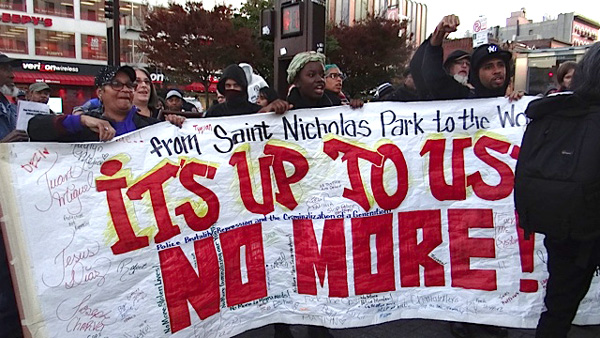
Harlem, New York, October 22, 2013. Photo: Catherine Watters
Harlem: People gathered on a very busy street corner in the heart of Harlem to denounce police brutality and speak out about how the Black and Latino people, especially the youth are being criminalized by this system. The crowd was mainly people from Harlem but there were also others, of all nationalities, including some who had come from New Jersey and Staten Island. One Black man from Yonkers said he had been in Harlem the weekend before and seen the chalking on the street with the names of those killed by the police and the announcement of the rally. He took a photo of the sidewalk and tweeted it to others and then decided to come himself.
During the rally there was a steady presence of people, including members of the Revolution Club, lined up alongside the speakers holding signs that said: “NO MORE! No More Stolen Lives!” People walking by were recruited on the spot to take up the signs and join in making this determined statement. At one point people listened intently as a speaker held up the Three Strikes poster with the quote from Bob Avakian and went through each of the three crimes of the system: Dred Scott, Emmett Till and Trayvon Martin. There were folks in the crowd who were old enough to remember the racist murder of Emmett Till and nodded their heads in remembrance. There were young people who were perhaps putting this all together for the first time, and were riveted by the truth of what the speaker was saying: That’s It For the System—Three Strikes, You’re Out!
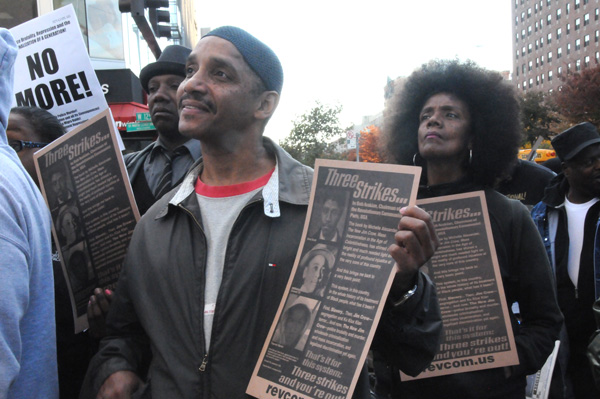
Harlem, New York, October 22, 2013.
Photo: Li Onesto/Revolution
Speakers included Noche Diaz and Jamel Mims from the Revolution Club; Deborah Sweet from World Can't Wait; Palina Prasasouk, from Witness Against Torture; representatives from the Peoples Organization for Progress; Jim Vrettos, a professor at John Jay College; and Carl Dix of the Revolutionary Communist Party, who had just arrived from the O22 rally in the Bronx. The statement from the Revolutionary Communist Party was read. A statement was read from Rev. Stephen Phelps from Riverside Church in Harlem.
After the rally there was a very spirited march through Harlem, spreading the message and determination of the rally out to many more people.
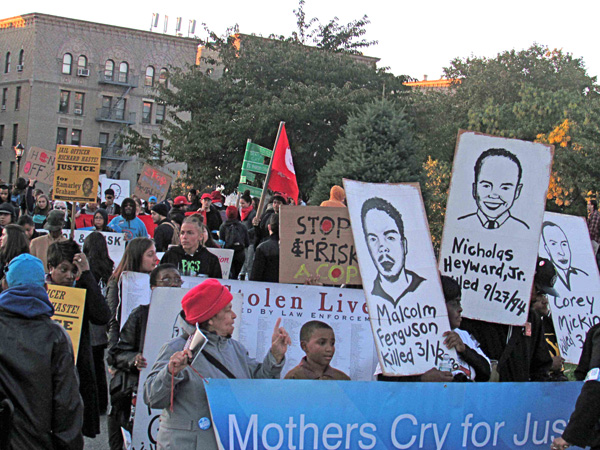
Bronx, New York, October 22, 2013
Bronx: About 150 people gathered in Joyce Kilmer Park, directly across from the Bronx Courthouse where over the years so many cases of police brutality have been whitewashed and declared “justified.” The crowd was mainly young, Latino, Black, Asian and white. Some had been to October 22 events before, and some were here for the first time, often due to their own or a loved one’s fresh experience with police brutality.
Representatives of several political groups spoke, including Carl Dix, a founder of the October 22 Coalition. Carl’s indictment of the system that unleashes violence and oppression on the people around the world, his assertion that only revolution could bring about a new world free of these horrors, and his challenge for people to get with the movement for revolution, was listened to intently.
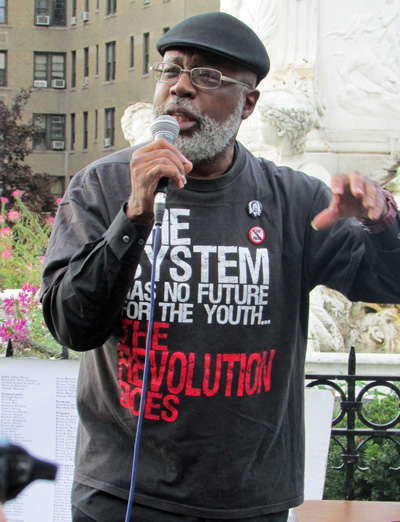
Carl Dix speaks at Bronx, New York rally.
Many speakers were parents of victims of police murder, some of whom had been fighting for justice for close to 20 years. These parents exposed and denounced the many ways that the system suppresses and evades the evidence of cold-blooded murder at the hands of their police; they expressed the pain—still achingly fresh—of having a child stolen in such a brutal manner; and through all that expressed their determination to keep fighting, while challenging everyone there to step up the struggle. One of them, Nicholas Heyward, whose 13-year-old son was killed by the police in 1994, said that his experience of trying to work through the system—with elected officials, prosecutors, courts—had brought him to the truth that Carl Dix had spoken, that nothing short of revolution could bring about justice for the people.
After the rally there was a spirited march through the streets of the Bronx, stopping at the notorious 42nd police precinct along the way. The march was welcomed by many in the Bronx, including small shopkeepers and street vendors.
Throughout the march and rally people expressed markedly different views about the source of police brutality and the solution to it. Many talked about how brutality is getting worse, but also that there is clearly growing discontent among the people, though still mainly under the surface. Many thought and hoped that if that could be fully aroused, then the people on top who are responsible for what the police do would make some serious changes. Others recognized that this oppression is so deep in the DNA of the system that it would take a revolution to end it, but still had many questions about whether this was possible, what would replace it, and how to be sure a new revolutionary government wouldn’t end up being oppressive as well.
Jamaica, Queens: O22 was marked in this neighborhood at a busy pedestrian mall on 165th Street and Jamaica Avenue. Among people here, there is deep anger over the police harassment and brutality, and stop-and-frisk actions. These oppressive actions are hated features of life in this predominantly working and lower middle class African American community. This is the neighborhood—which also has sizable sections of Caribbean, South Asian and Latino immigrant families—where the unarmed Sean Bell was killed, on the evening before his wedding, by plainclothes cops in 2006; and where one of the Stop Mass Incarceration Network’s “stop stop-and-frisk” civil disobedience actions took place in 2011 at the NYPD’s 103rd Precinct. Organized by an activist clergy person known for her outspokenness against police brutality and the incarceration of Blacks and Latinos, five people gathered and distributed flyers, and along with homemade signage, called out the escalation of police violence in the predominantly middle class African American community. A local weekly community newspaper recorded their action.
Chicago
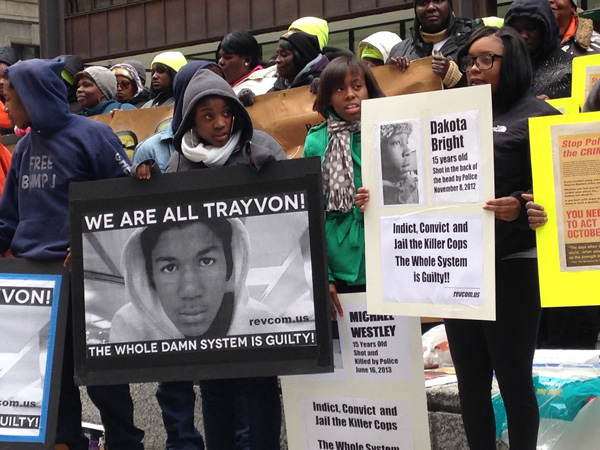
Chicago, Illinois, October 22, 2013
The crowd of over 200 that gathered for a downtown rally was overwhelmingly African-American and mainly young—in their teens and twenties. An effort had been made to reach out to people from two high schools, a faith oriented community organization that focuses on issues of criminalization, and a college. There were families of people killed by the police and those wrongfully convicted; and there were also people from other colleges, the Occupy movement, and many others who heard about it from the internet or from a flyer. One woman from the Occupy movement had stayed up the night before to produce a beautiful painting symbolizing “the death of Jim Crow.” There were some Latinos and a handful of white people among those that attended. The event was powerful—especially with the participation of youth and others who are “directly under the gun” of police brutality and criminalization. But what was noticeable was that there was not many from other sections of society. A young woman who had organized for the day commented that this could leave the youth “feeling very alone—you need all colors of the rainbow.”
Some at the protest have been active around issues of police brutality and mass incarceration for years, but for most it was their first protest and they came to it with great energy. There was a joy among the youth in being at an event where the outrages they face every day were recognized and condemned—laughing, almost dancing as the march snaked through downtown. People called out the cops with the chant “Indict, Convict, Send the Killer Cops to Jail! The WHOLE DAMN SYSTEM is Guilty as HELL!” Letting everyone know, “WE ARE NOT SUSPECTS! WE ARE HUMAN BEINGS!” and “Being Black (Brown, young, immigrant) is not a Crime, But pigs still mess with us All the Time!” These were two very popular chants. A poster with Trayvon’s face and “the whole system is guilty” were held high at the rally and throughout the march. An office worker who commutes in from the suburb came out to the event. He said this is one of very few times where these youth have a voice.
Atlanta
About 60 people gathered in Troy Davis Park downtown for a speak-out and march to mark O22, joined for the initial speak-out by several dozen homeless people and others hanging out in the park, many of whom put on bright orange stickers for the day passed out to the crowd.
At the park, the mother of Zaus Barnett, who was shot 12 times and killed by Atlanta police earlier this year, spoke movingly and made the point that this wasn’t just about her son but that everyone was affected. The co-MCs, a spokesperson for Revolution Books and a representative from the NAACP Criminal Justice Committee, read out names and stories of Stolen Lives and led the crowd in the Stolen Lives Pledge. As the march was ready to take off, Copwatch alerted the crowd that someone was being harassed by the police on the street adjacent to the park, so people went over to expose what was going on and call out the police. The spirited march then took to the streets with drums and loud chants, and made several stops through downtown. The first was in front of the Georgia State University building that houses GILEE, the Georgia International Law Enforcement Exchange—a joint training program between Georgia and Israeli police. A representative from the GSU Progressive Student Alliance exposed the program and pointed out that police brutality and repression are international issues, calling for solidarity with the Palestinian people living under Israeli repression. After marching past the main transit station and a shopping area where many people joined in the chants and raised fists, the march stopped in front of the ICE field office responsible for immigrant “Enforcement and Removal Operations.” A youth from Georgia Undocumented Youth Alliance spoke to the crowd about the detention and deportation of immigrants, and said that President Obama could end this horror through executive order but has refused to do so. The final stop was the Atlanta Pretrial Detention Center, the main city jail.
A longer speak-out was held, which included two former prisoners, one of whom participated in the Georgia prison hunger strike in 2011, and another who spent 30 years in a Texas prison, including 12 years in solitary confinement. Other speakers included the RCP, Copwatch and the Georgia Undocumented Youth Alliance, as well as several people who came up to testify about experience with police brutality. The MC also pointed out a few of the nearly 1,000 video surveillance cameras on poles and buildings in the city monitored by the Atlanta Police, who have a goal of installing 10,000 cameras over the next 5 years. And as the march passed the transit station on the way back to the park, a youth came up and got on the bullhorn to let everyone know that a woman had just been beat down by the police at the station earlier in the afternoon, underscoring the pervasiveness of police brutality and the need for massive resistance. Throughout the day about 50 copies of Revolution were distributed along with several hundred palm cards promoting BA Speaks: Revolution—Nothing Less! and BAsics quote 1:24, "The role of the police is not to serve and protect the people. It is to serve and protect the system that rules over the people..."
Seattle
About 100 people rallied in Seattle, followed by a march—with no shortage of people speaking bitterness, as so many have lost loved ones to the plague of murders by the police. A younger Latino man told of losing his beloved brother to the police violence in Arizona: "You know soldiers with PTSD from Iraq? Well, I have PTSD, and it's from a war too. There is a war in Arizona. I had to escape it. The police there are conducting a war in the streets against people, they gun you down in the street. I lost my brother!"
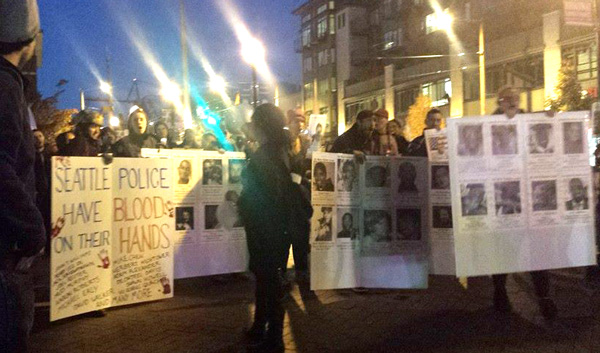
Seattle, Washington, October 22, 2013
A friend of Prince Gavin, a Black soldier murdered by police in Tacoma, Washington, said she has learned to "never call 911. You just can't. They will come and kill people.” There was a friend of Victor Duffy Jr., a Black youth who, suffering from mental illness, confused, and unarmed, was blinded by pepper spray and then viciously tasered and crushed to death by a gang of cops. Talking about Duffy, she became completely overcome and broke down with emotion, saying, "I miss him so badly, and feel so for the pain of Victor's family, and how so very much we all miss the joy he brought into our lives." The grandmother and sister of the Native youth Jimi Johnson, who this spring died in the Mason County, Washington, jail, spoke of the value of his life, and the unanswered and ignored questions around his death. A speaker against marijuana prohibition told of the historically racist basis of anti-marijuana laws, and tied that in to mass incarceration.
A comrade read the O22 statement from the Revolutionary Communist Party and the need for revolution to actually END police brutality was spoken to and fought for in different ways throughout the rally and march. This was controversial. Not everyone agreed with bringing the need for revolution to the forefront of the protest, and this was reflected in disagreements over chants and tactics during the march. The protesters divided out between those who wanted to understand and end the epidemic of police brutality, including those giving consideration to the need and possibility of communist revolution; and those who wanted the main purpose of the protest to be venting personal frustration at the cops while basically accepting that the nightmare will always continue. Throughout the controversy, there were many who stood with the revolutionaries, and had their back. In a discussion after the protest two young women said they also really appreciated how the revolutionaries had addressed patriarchy and made connections between the different horrors in the world.
The marchers refused to be intimidated by an overwhelming number of cops surrounding the march and planned to go by the East Precinct station of the notoriously brutal Seattle Police Department (SPD). In clear and criminal violation of the people's right of assembly and speech, SPD cops blocked the street and armed with clubs and deadly firearms they prevented the march from even going down the street the precinct is located on. Here people erected a sign with bloody hand prints on it, saying "Seattle Police You Have Blood on Your Hands" and shouted out, one by one, the deadly toll of the names of those murdered by the SPD.
The night was transformative for a number of people. One young student had expressed fear of marching in a protest against police brutality precisely because of the violent nature of the police—by the end of the march, she was at the very front. Two of the speakers who lost loved ones to the police were not sure if they could speak, but each found their courage after hearing the testimony and speeches of others. Two young men, one Latino and one white, during the march had together carried a very large placard listing hundreds of stolen lives nation wide.
New connections were made among people who want to connect to the October 22 Coalition, and who want to end this horror and other horrors of this world. Connections were also made with the revolution, with a number of people who were serious about the world needing to change said they'd be coming to the upcoming screening of a clip from the film BA Speaks: Revolution—Nothing Less!
Houston
During lunch at a major university in Houston, a revolution corner was setup in a busy plaza. The scene created quite a stir and some of the students took up the call to join with the protests on O22. A bunch of students pulled their hoodies up as they walked by, and others put on black armbands. Several students stopped to write their messages on signs. In response to the argument that it will take “Revolution, Nothing Less!” a women stopped and said, “I really like this. That’s exactly what we need”, and took her black hoodie from her bag and put it on.
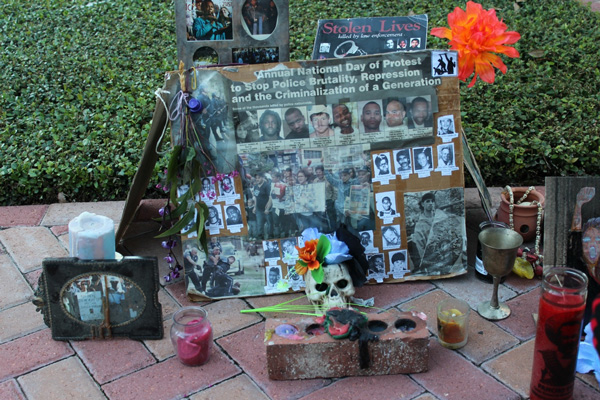
Ofrenda created for National Day of Protest, Houston, Texas, October 22, 2013
Later in the day, a few dozen people converged in downtown Houston to rally. There were lifelong activists, young people, some from the Occupy movement, freethinkers, people from a Black community, and revolutionary communists. Laid out on the sidewalk was a beautiful Mexican-style Stolen Lives ofrenda (altar) that two young women had made, dedicated to the many thousands murdered by police. They had taken pictures from the Stolen Lives Project book, and mixed it with their own art.
The march took off through the courthouse district to the county jail—some held homemade signs, others carried the Three Strikes posters. More people had joined in by the time the march got to the jail and several people came up to the mic to tell their stories of brutality at the hands of this system and to deliver their message of NO MORE! One young woman said, “There are so many ways they control you, they got you on paper, on parole, but we can’t be afraid to speak out!” Emboldened by this outpouring, other people came up to speak. One Black man told how he was assaulted by the police when he was 19, and then spent 23 of his 44 years in jail, for something he didn’t even do. Dramatically pulling his partial dentures out of his mouth and waving them before the crowd, he described how the cops beat the shit out of him, knocking his teeth out. Another man yelled. “Fuck the Police!” pointing to the jail and said, “They beat you up in there!” He pulled up his shirt to show marks where he had been tased. At the end of the day, people were energized with what we accomplished, and several people were moved to check more into BA and the movement for revolution.
Cleveland
75 people of different nationalities, mostly youth and students, rallied and marched through downtown, spirited and bold from beginning to end. A number of youth came to the event and right away helped get banners and pictures displayed of people killed by the police and Trayvon Martin. They went all over the area getting out hundreds of flyers.
Before the rally began, a banner with the quote “No more generations of our youth...” (BAsics 1:13) drew people. A young person started to call on people to sign it. Soon there was line of people waiting to sign.
Many different people spoke at the rally. An organizer for the immigrant community spoke about the attacks and killing of immigrants and massive deportations going on under Obama. Some mothers and relatives of loved ones killed by the police spoke about how the fight against police brutality and murder has to get stronger and that they are committed to being part of doing that. Members of a Black community group that has fought against and exposed police killings spoke. Others spoke about how they have experienced profiling and brutality at the hands of the police and are glad to have met up with this protest. One woman spoke on a vicious attack on her niece and how she went to jail for it. A Revolution seller read the RCP statement. As the words of the statement rang out, some people responded to the need for revolution, applauding and speaking out several times. When it said, “When people no longer have to say 'how long' and they can walk in the liberating sun of a whole new day," people smiled and clapped to hear of an alternative to this system of horrors.
The march took off, leading with a banner, “Stop Police Brutality, Repression and the Criminalization of a Generation,” a huge picture of Trayvon Martin, and lots of signs and pictures of those killed by the police. We marched to the Justice Center, a target people feel deeply about because of all the injustice that goes on there. Prisoners crowded to a window with fists in the air and we returned the same, chanting, “Prisoners are HUMAN BEINGS.” People marched on chanting loudly and with deep conviction, like “Killer cops by the hour/What do we say/Fight the power!” and more.
There were different sentiments among the people there. A Black man in his 20s was drawn to revolution. He marched and carried the banner. He said he thought what we were saying about revolution was right. He said he was going to a community college to take a speaking class to be able to speak to people about these things. Another Black man, maybe in his 30s, spoke with outrage about a friend who is in prison. He carried the banner and said it was an honor to do it.
Hawai`i
It would have been hard to be on the University of Hawai`i-Manoa Campus on Tuesday, October 22 and not know that it was the day to Stop Police Brutality, Repression and the Criminalization of a Generation. Large banners had been hanging from a central campus building for a week. Facts about U.S. prisons, photos of victims of police brutality, the Three Strikes poster, and the front pages and centerfolds of Revolution had been appearing on bulletin boards for several weeks.
On the morning of October 22 about 30 lawn signs with facts about the prison system lined sidewalks and displays of large photos of victims of police murders were strung on clotheslines between palm trees along the central mall. A small crew passed out leaflets, armbands and chalk on the mall for three hours, and at noon a small but loud and energetic march demanding Justice for Kollin Elderts wound through campus. When the campus security police confronted a young student leading the march and told her she was disturbing classes and was facing arrest she righteously responded: “This is a protest. It should disturb students” and refused to back down. Since the march had reached the endpoint the guard backed down and she wasn’t arrested.
Kollin Elderts was a 23-year-old Hawaiian man who was murdered in cold blood by a U.S. State Department Agent at McDonald’s in Waikiki during the 2011 APEC Conference in Honolulu. The trial of the U.S. agent in July-August 2013 ended with a hung jury and has been re-scheduled for summer 2014 while the agent is back on the job at the State Department. The murder of a Hawaiian youth by a U.S. federal agent tapped into deep anger over the role of the federal government in the continued occupation and militarization of Hawai`i and the government no doubt hopes that delaying the trial for more than two and a half years after the murder will be long enough for the people to forget but a movement is coming together to continue to fight for justice for Kollin Elderts.
650 leaflets were distributed, about 50 students put on black armbands; some took chalk to write their own messages and throughout the day people stopped by the photo displays to read about the people who had been murdered by the police. Some shook their heads in disbelief; some said they just felt sad and some were angry. Some shared stories about their own experiences. Several faculty said they were talking about police brutality and the U.S. prison system in their classes, and one said he was using Revolution newspaper for coverage and facts.
For a day thousands of students, faculty and staff were forced to wake up to the reality of police brutality and the horror of U.S. prisons.
Jacksonville, Florida
100 came out at 4 pm at the Hemming Plaza. The stage had tables against the death penalty; petitions for Gov. Scott and D.A. Angela Corey demanding release of Marissa Alexander; and petitions to change the name of Nathan B. Forrest (KKK founder/leader) High School. We got rained out but then marched in singing to the City Council meeting. 20 demonstrators spoke at the podium—children, homeless, mothers of killed or jailed youth & community leaders. Then we picketed in front of City Hall.
Greensboro, North Carolina:
A rally of 35 people was held at the brand-new 1,032-bed "Guilty" County (Guilford) jail. Speakers talked about the new Jim Crow, "Slow Genocide," school-to-prison pipeline. A woman spoke of how the Greensboro police murdered TWO of her family and then covered it up. Her husband was killed over 20 years ago in front of her four-year-old son and then 18 years later that same unarmed son was killed by police. She said how Black lives meant nothing in this system.
50 people rallied and marched through the Smith Homes. Speakers spoke about the everyday harassment and recent murders by police—in Charlotte of Jonathan Ferrell (who had just been in a car wreck and was seeking help and was gunned down) and in Fayetteville of 16-year-old Shakur McNair who was objecting to the treatment of his mother after police were called to settle a domestic dispute. The march stepped off chanting "Shakur didn't have to die, we all know the reason why—the whole system's guilty".
Drums and chants rang out through the streets and over 50 more joined in. Several young people grabbed stacks and passed out cards with the Bob Avakian quote: "No More Generations of Our Youth..." and on "The Role of the Police..."
At the conclusion of the march, several more spoke, including a youth and student group from the Beloved Community Center about continuing the fight against police brutality. Another speaker asked people to help with the Stolen Lives Project. A speaker from the Stop Mass Incarceration Network urged people to join in this sharp battle that has reached epidemic proportions nationwide including neighborhoods such as this. The RCP statement was read and copies were handed out all day to participants and spectators.
The day concluded, as it does every October 22, with the mother of a victim of police murder leading everyone in saying the "Stolen Lives Pledge."
Detroit
A group, including families of victims, met at the 15th precinct. Some years ago, a person was killed by police out of this precinct; another was killed while detained there. The group released balloons with several Stolen Lives names attached to each. Later, a Speak Out was held at the main City bus terminal downtown. People stepped forward to take over the mike and called on all the people waiting for buses to get out of normal life, step up to the mike to speak out, and get involved in the movement to stop police brutality. Stories about police harassment were told. One of the people at the speak out made his own flyer with a graphic headline, "Under the Gun," going on to say, "Every 40 hours a Black man, woman or child is killed by police security guards or 'self-appointed' law enforcers, according to a new report." The flyer featured pictures of victims, including Trayvon Martin. A deep discussion formed among several participants, digging into the whole history of Black people in the U.S.—oppression and resistance—and how people saw solutions.
As the Speak Out gained momentum, the police sent first one, then five cars to the scene. After a supervisor checked it out, a cop came and said we have no right to do this "on public property" and threatened to ticket or arrest us. We then spread out through the large bus terminal to continue to take out O22.
Soon after, family members of police murder victims arrived. They spread out through the crowd with leaflets, talking to people. They talked about the new police chief who has appointed an "all-star team" to clamp down on the youth. These are the very same cops who have killed or brutalized many people in Detroit, including their family members. High school youth and others took very seriously the message that the "slow genocide could develop into a faster genocide."
Lynn, Massachusetts
About 100 people gathered outside the Lynn City Hall. Earlier in the month, about 75-100 people had attended a rally here to protest the killing of Denis Reynoso (see correspondence below: "The Killing of Denis Reynoso").
The MC of the rally announced that this was part of the National Day of Protest to Stop Police Brutality. There were more youth of different nationalities, a number of whom spoke bitterness to the crowd.
A revolutionary addressed the rally. He represented himself as a supporter of the Revolutionary Communist Party and told the audience that what he had to say might be controversial to many but needed to be heard. He presented that the murder of Denis Reynoso and the grief his fiancé and family were going through were not isolated but part of a broader systematic assault aimed overwhelmingly at Black and Latino youth that was rooted in this system, and drew on the Ramarley Graham murder in New York City as another recent example—police barging into his home and gunning him down in front of his family.
He came back to the point that it is this system that is the source of these outrages and we cannot expect to get justice from this system. Then, in an extremely important point, he spoke about how Denis had joined the U.S. Army because that is what you are taught that you are “suppose to do” and was sent to Iraq to be part of the vicious military machine of U.S. imperialism imposing and enforcing the very same oppressive conditions on people around the world that Denis, himself became the victim of.
This was very controversial point—one of the main arguments being raised by the family and friends was that Denis didn’t deserve to die because he was a vet! The main photo of him on T-shirts and posters is in his uniform. Previous speakers included in their comments the fact that Denis didn’t deserve to die because he had “served his country.”
The speaker went on to say that another world IS possible but it would take a revolution to get rid of this system and that was what we were all about—people should check out Revolution newspaper and the film BA Speaks: Revolution—Nothing Less! Overall this rap got a big applause from the crowd and immediately afterward some people came up to the speaker and other people distributing Revolution to get copies of the paper and to find out more about the DVD of Revolution—Nothing Less! One group of young men, strongly influenced by Islam and who mentor in an alternative school in Lynn, spoke with revolutionaries about the possibilities of bringing the film into their school. After hearing the speaker and looking at Revolution, they said they thought there were big differences but that it seemed like it would be very important to watch the DVD and to engage more deeply with what it would take to bring a different world into being.
* * * * *
Revolution received the following correspondence:
The Murder of Denis Reynoso
From readers:
Lynn, Massachusetts is a small working class city of 90,000 12 miles north of Boston. Over the past 25 years, it has gone from almost 100% white to very multi-national with 12% African American and over 30% Latino, mainly Caribbean. Over the same period, the major employer, General Electric, has reduced its workforce by several thousand. Unemployment in the city is three times that of Massachusetts as a whole and twice the national average. So there is an aging (and shrinking) white population and a younger and growing African-American and immigrant population.
While only a few miles north of Boston and well within the dense urban ring around the city, Lynn is geographically isolated and a world apart from the Boston/Cambridge environment that is promoted nationally—of elite universities, high tech start ups and bio-medical centers. Police brutality is a common occurrence in the Black and immigrant communities but is seldom reported in the Boston media.
On September 6, Lynn police entered the home of Denis Reynoso, a 30-year-old Dominican American, and shot and killed him in front of his 5-year-old son. The police were responding to a “disturbing the peace” report that had been filed after Denis had reportedly gotten into an argument outside his home with a passing motorist. The three police on the scene entered his home with guns drawn and claimed that Denis had lunged for one of the officer’s guns. After shooting Denis three times and while waiting for an ambulance, the police searched his home for drugs or weapons (none were found) and stripped his son’s blood stained shirt as possible evidence. Denis died in the hospital a few minutes later.
The police involved were briefly suspended and the police department launched an internal investigation which is still ongoing.
Denis’s fiancé and the extended family and friends were both stunned and angered by the official story. Denis had tried to live his life the “right way,” joining the army, doing a tour of duty in Iraq, later transferring to the National Guard. He had recently become engaged to the mother of his two children and was working as a clerk in a local post office. He was soft-spoken and well liked in his neighborhood.
Denis’s fiancé started a “Justice for Denis” Facebook page and hooked up with a couple of local activists connected with “Defend the 4th (Amendment),” a local group of activists, law students and professors who are involved in the battle against illegal search and seizure of individual’s homes.
Together, the family, friends and local activists, collected money to print “Justice for Denis” T-shirts and stickers. They called for an October 5 “Justice for Denis” rally that marched through downtown Lynn to the police department with their demand for an independent investigation.
A small team of revolutionaries began traveling to Lynn a couple of weeks before the Oct. 5 rally, canvassing the neighborhood where Denis was killed, connecting with family members and neighbors, going to nearby markets and onto a local community college taking out Revolution newspaper and the BA Speaks: Revolution—Nothing Less video. While they received a good welcome, they were surprised that many of the students at the college were unaware of the killing. At the same time, local residents whom were mainly immigrants were not comfortable talking publicly.
About 75-100 people attended the October 5 rally, where many of Denis’s relatives and some local activists spoke. Revolution newspaper was a noticeable presence at the rally and someone from the paper spoke briefly towards the end at the police station.
While revolutionaries have met and talked with Denis’s fiancé and other family members, they had not had an opportunity to actually sit down with them. Even now, the fiancé is very grief-stricken by the murder. So the announcement that the organizers of “Justice for Denis Reynoso” had officially endorsed and taken up October 22 National Day of Protest to Stop Police Brutality, Repression and Criminalization of a Generation was based mainly on people reading the coverage in Revolution in the weeks leading up to the 22nd.
There has been a lot of discussion and struggle among people taking Revolution newspaper out in this mix about how to apply a correct understanding of “Fight the Power, and Transform the People for Revolution,” and how the most important contribution that we can make is to bring out to people that things don't have to be this way—another world is possible.
If you like this article, subscribe, donate to and sustain Revolution newspaper.
